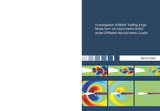Citation link:
http://dx.doi.org/10.25819/ubsi/10448| DC Field | Value | Language |
|---|---|---|
| crisitem.author.orcid | 0009-0008-2389-1797 | - |
| dc.contributor.author | Stahl, Kathrin | - |
| dc.date.accessioned | 2024-01-31T10:42:51Z | - |
| dc.date.available | 2024-01-31T10:42:51Z | - |
| dc.date.issued | 2023 | de |
| dc.description.abstract | This work deals with the noise from the trailing edge of a two-dimensional airfoil segment in airflow. Of interest is the mechanism of flow-induced noise generation at the trailing edge with special consideration of its bluntness. Unlike in many well-known studies, a typical asymmetric airfoil is chosen for the segment, here the DU93W210 airfoil. This is frequently used for wind turbines, for example. By shortening the chord length, the bluntness of the trailing edge is increased in several steps. Furthermore, the inflow velocity and the angle of attack are varied. An enlargement of the angle of attack corresponds to an increase of the aerodynamic load on the airfoil. The study is limited to the case of a fully turbulent boundary layer from leading to trailing edge on both, the suction and pressure side. This is achieved by operation at relatively large values of the chord-based REYNOLDS number (up to 1.2x106) in combination with a carefully chosen boundary layer tripping. The results of the study are primarily obtained using the numerical Lattice- BOLTZMANN method as a computational aeroacoustic method, but are successfully validated randomly by measurements in an aeroacoustic wind tunnel. The observed flow-induced noise is broadband with a case-dependent pronounced tonal component. As long as the aerodynamic load on the airfoil, i.e. the angle of attack, is comparatively low, a dominant tone exists with a sound pressure level that increases with the bluntness of the trailing edge. If the load is increased, the tone disappears and only broadband noise is present. The frequency of the tone decreases with the bluntness and increases with the REYNOLDS number. The criterion of BLAKE for the existence of a tone at blunt trailing edges turns out to be necessary but not sufficient. Already an analysis of the time-averaged velocity field shows that with increase of the bluntness a second vortex gradually develops in the near wake. The vortices alternately detach from the trailing edge and a vortex street is generated. Using methods of modal analysis, the flow field could be decomposed into coherent structures. One of these coherent structures, which is spatially and temporally resolved in detail, represents the vortex street described above. At high bluntness and comparatively low aerodynamic loading of the airfoil segment, the shed vortices are located close to the trailing edge. As the aerodynamic loading of the airfoil increases, the asymmetry of the flow between the suction- and pressure-side boundary layers becomes larger. As a result, even with comparatively blunt trailing edges, the vortices form further downstream from the trailing edge, which explains why the typical "blunt trailing edge" signature is absent. | en |
| dc.description.abstract | Diese Arbeit befasst sich mit dem Schall von der Hinterkante eines zweidimensionalen Tragflächensegments in einer Luftströmung. Von Interesse ist der Mechanismus der strömungsinduzierten Schallerzeugung an der Hinterkante unter besonderer Berücksichtigung deren Stumpfheit. Anders als bei vielen bekannten Studien wird eine typische asymmetrische Profilierung des Tragflügelsegments gewählt, hier mit dem Profil DU93W210. Dieses wird z.B. häufig bei Windturbinen eingesetzt. Durch Verkürzen der Sehnenlänge wird die Stumpfheit der Hinterkante in mehreren Schritten erhöht. Variiert werden weiterhin die Anströmgeschwindigkeit sowie der Anstellwinkel. Eine Vergrößerung des Anstellwinkels entspricht einer Erhöhung der aerodynamischen Belastung des Tragflügels. Die Studie beschränkt sich auf den Fall einer vollständig turbulente Grenzschicht von der Vorder- bis zur Hinterkante sowohl auf der Saug- als auch der Druckseite, was durch die relativ großen Werte der sehnenbasierten REYNOLDS-Zahl (bis zu 1.2x106) in Kombination mit einem sorgfältig gewählten Grenzschichttripping erreicht wird. Die Studienergebnisse werden primär mit dem numerischen Lattice-BOLTZMANN-Verfahren als Computational Aeroacoustic Methode erzielt, jedoch stichprobenartig durch Messungen in einem aeroakustischen Windkanal erfolgreich validiert. Der beobachtete strömungsinduzierte Schall ist breitbandig mit einer fallweise ausgeprägten tonalen Komponente. Solange die aerodynamische Belastung des Tragflächensegments, d.h. der Anstellwinkel, vergleichsweise gering ist, existiert ein dominanter Ton, dessen Schalldruckpegel mit der Stumpfheit der Hinterkante wächst. Wird die Belastung erhöht, verschwindet der Ton, und es ist dann nur ein breitbandiges Rauschen hörbar. Die Frequenz des Tons nimmt mit der Stumpfheit ab und der REYNOLDS-Zahl zu. Das Kriterium von BLAKE für die Existenz eines Tons bei stumpfer Hinterkante erweist sich als notwendig aber nicht als hinreichend. Bereits eine Analyse des zeitlich gemittelten Geschwindigkeitsfelds zeigt, dass sich mit Erhöhung der Stumpfheit allmählich ein zweiter Wirbel im nahen Nachlauf entwickelt. Diese Wirbel lösen sich alternierend von der Hinterkante ab und es entsteht eine Wirbelstraße. Mit Methoden der Modalanalyse konnte das Strömungsfeld in kohärenten Strukturen zerlegt werden. Durch eine dieser räumlich und zeitlich im Detail aufgelösten kohärenten Strukturen wird die zuvor beschriebene Wirbelstraße repräsentiert. Bei großer Stumpfheit und vergleichsweise geringer aerodynamischer Belastung des Tragflügelsegments befinden sich die abgehenden Wirbel nahe an der Hinterkante. Mit zunehmender aerodynamischer Belastung des Tragflügels wird die Asymmetrie der Strömung zwischen saug- und druckseitiger Grenzschicht größer. Dies hat zur Folge, dass selbst bei vergleichsweise stumpfen Hinterkanten sich die Wirbel erst stromabwärts von der Hinterkante ausbilden, weshalb die typische "blunt trailing edge"- Signatur ausbleibt. | de |
| dc.identifier.doi | http://dx.doi.org/10.25819/ubsi/10448 | - |
| dc.identifier.uri | https://dspace.ub.uni-siegen.de/handle/ubsi/2661 | - |
| dc.identifier.urn | urn:nbn:de:hbz:467-26611 | - |
| dc.language.iso | en | de |
| dc.source | Düren: Shaker, 2023. - ISBN 978-3-8440-9285-1 | de |
| dc.subject.ddc | 620 Ingenieurwissenschaften und zugeordnete Tätigkeiten | de |
| dc.subject.other | Blunt trailing edge noise | en |
| dc.subject.other | Vortex shedding noise | en |
| dc.subject.other | Airfoil | en |
| dc.subject.other | Turbomachinery | en |
| dc.subject.other | Wind turbine noise | en |
| dc.subject.other | Lattice-Boltzmann method | en |
| dc.subject.other | LBM | en |
| dc.subject.other | Aeroacoustic wind tunnel experiments | en |
| dc.subject.other | Far-field acoustics | en |
| dc.subject.other | Spectral proper orthogonal decomposition | en |
| dc.subject.other | SPOD | en |
| dc.subject.other | POD | en |
| dc.subject.other | High Reynolds number flow | en |
| dc.subject.other | Aeroacoustic simulation | en |
| dc.subject.other | Flow induced noise | en |
| dc.subject.other | Geräusch der stumpfen Hinterkante | de |
| dc.subject.other | Wirbelablösegeräusch | de |
| dc.subject.other | Tragflügelprofil | de |
| dc.subject.other | Turbomaschinen | de |
| dc.subject.other | Lattice-Boltzmann-Verfahren | de |
| dc.subject.other | Aeroakustische Windkanalexperimente | de |
| dc.subject.other | Fernfeldakustik | de |
| dc.subject.other | Spektrale orthogonale Zerlegung | de |
| dc.subject.other | Strömung mit hoher Reynoldszahl | de |
| dc.subject.other | Aeroakustische Simulation | de |
| dc.subject.other | Strömungsinduziertes Geräusch | de |
| dc.title | Investigation of blunt trailing edge noise from an asymmetric airfoil under different aerodynamic loads | en |
| dc.title.alternative | Untersuchung des Geräuschs von stumpfen Hinterkanten eines asymmetrischen Profils unter verschiedenen aerodynamischen Belastungen | de |
| dc.type | Doctoral Thesis | de |
| item.fulltext | With Fulltext | - |
| ubsi.contributor.referee | Roller, Sabine | - |
| ubsi.date.accepted | 2023-08-07 | - |
| ubsi.extern.issn | 0945-2230 | - |
| ubsi.organisation.granting | Universität Siegen | - |
| ubsi.origin.dspace5 | 1 | - |
| ubsi.publication.affiliation | Institut für Simulationstechnik und wissenschaftliches Rechnen | de |
| ubsi.publication.affiliation | Institut für Fluid- und Thermodynamik | de |
| ubsi.source.extern-title | Berichte aus der Strömungstechnik | de |
| ubsi.source.isbn | 978-3-8440-9285-1 | - |
| ubsi.source.issued | 2023 | de |
| ubsi.source.link | https://www.shaker.de/de/content/catalogue/index.asp?lang=&ID=6&category=39 | de |
| ubsi.source.place | Düren | de |
| ubsi.source.publisher | Shaker | de |
| ubsi.source.title | Investigation of blunt trailing edge noise from an asymmetric airfoil under different aerodynamic loads | de |
| ubsi.subject.ghbs | XIWD | de |
| ubsi.subject.ghbs | WDF | de |
| Appears in Collections: | Hochschulschriften | |
Files in This Item:
| File | Description | Size | Format | |
|---|---|---|---|---|
| Dissertation_Stahl_Kathrin.pdf | 11.94 MB | Adobe PDF |  View/Open |
This item is protected by original copyright |
Page view(s)
910
checked on Nov 25, 2024
Download(s)
56
checked on Nov 25, 2024
Google ScholarTM
Check
Altmetric
Items in DSpace are protected by copyright, with all rights reserved, unless otherwise indicated.

